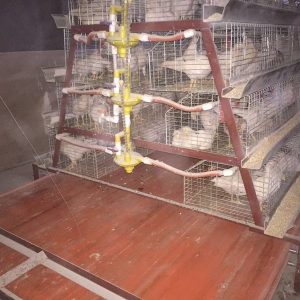1. Variety factors
Laying hens are generally divided into two types: red shell layer and powder shell layer. Divided by breed, the consumption of red chickens is generally higher than that of powdered chickens, and the weight of red chickens is higher than that of powdered chickens, and it is higher than that of powdered chickens in terms of basic maintenance energy alone.
The representative breeds of red chicken are Hailan Brown, Roman Brown, Isa Brown, as well as domestic Jinghong and Jinfeng breeds. Representative varieties of powder chicken are Hailan ash, Roman powder, Yisha powder, as well as domestic Beijing powder, Beijing white chicken, and Nongda varieties.
2. Seasonal factors
Laying hens have a suitable temperature range whether they are in the reserve period or during the laying period. In this suitable temperature range, the amount of feed, weight gain, and egg production benefit are the best. Exceeding this temperature range will affect feed cost performance, egg production efficiency, weight gain and other factors. For example, the temperature of 13-year-old chicks is 34℃~36℃. The growth of chicks below this temperature is likely to cause diseases, and the growth of chicks above this temperature is hindered. They are easily dehydrated and die.
The best environment temperature for laying hens is 18℃~22℃, lower or higher than this temperature, the egg-to-feed ratio of laying hens increases, which is easy to cause disease. Correspondingly, it affects the performance of the flock (feed consumption, egg production rate, Death rate, weight gain, feather condition). For example, in autumn and winter, the temperature is lower than the appropriate temperature, the first cause of this is the provision of material consumption, because the chicken has a certain self-regulating function, and the current needs can not be met through self-regulation before it will reduce its own production performance. Such as egg production rate, weight gain, feather growth status, etc.
3. Age factor
Laying hens increase with age during the laying period. The body weight will increase, the basic consumption will increase, and the nutritional requirements will increase. (See Table 1)
If it is the same nutrient level feed during the laying period, the older the chicken, the higher the feed consumption.
4. Feed ingredient factors
Laying hens are animals that need energy, so the nutrition of the feed completely determines the consumption of the layers. For example: the daily nutrient requirements of Hailan brown layer hens during peak egg production are: metabolic rate 285-305 calories and protein 17-18.5 grams.
The formula for calculating the metabolic energy of laying hens is:
White eggshell system: ME (kcal)=W(170—2.213+2E+5△W
Red egg shell system: ME (kcal)=W(104—2.0T)l+2E+5△W
W——weight (kg)’11_—ambient temperature (℃)E——average egg production per day (gram)△W——average daily weight change (gram) see Table 2
The energy raw materials in the feed are corn and oil, and the coefficient of change in the metabolism of oil is not large and can be regarded as constant. However, the coefficient of change in the metabolic rate of corn changes due to changes in moisture. Therefore, the moisture content of corn raw materials must be tested when purchasing, so that the overall nutrition of the feed can ensure accuracy.
Use high-moisture corn feed formula adjustment: When corn exceeds 14% of safe water, the simple conversion method is: corn with 14% moisture, metabolic energy 3240 kcal/kg, crude protein 8%, when corn When the water content is 16%, the metabolizable energy is 3165 kcal/kg (3240+86×84), and the crude protein is 7.8% (8+86×84).
Often when farms use high-moisture corn, if the feed is produced according to the original formula, the nutrient level of the feed is relatively lower than the theoretical level, the layer will show an increase in feed intake. It is not right to increase energy simply by increasing the proportion of corn. First, it dilutes other nutrients in the diet. Second, the feed intake of the laying hens is limited. If the limit is exceeded, the digestive function will decrease and the death rate will increase. .
In order to increase the metabolizable energy level of the diet, the addition of fat must be considered.
5. Feeding management factors
Scientific management methods can quickly and effectively improve the efficiency of laying hens, which is also the core content of the breeding industry.
The replacement of breeders, the curing of feeding time, the regularity of drinking water, daily environmental sanitation operations, chicken flocks, density, air quality and other issues have an external relationship with the consumption of layers.
To sum up. There are many factors that affect the increase in daily feed consumption of laying hens. It is necessary for the farm to start from its own management. Ultimately, it will increase the efficiency of the entire laying hen breeding and improve the breeds, management methods and daily operations of the laying hens.

